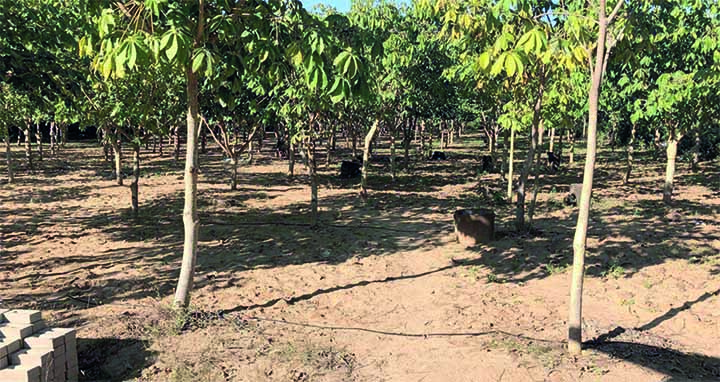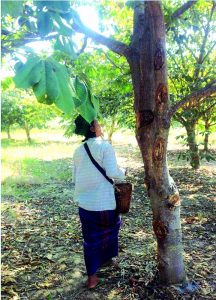By May Yu-Myo Aung (MANA)
Gum of Sterculia versicolor has been used across the world for some 100 years. In early 20th Century, Sterculia versicolor gum was used on a wider scale due to ingredient of it in tragacanth gum. Sterculia versicolor gum contains usable chemical properties more than tragacanth gum. The World Food Organization recognized Sterculia versicolor gum as a supplementary food under E-416 in 1911.
Sterculia versicolor plants originally thrive in India, Myanmar and Sri Lanka. Now, Senegal, Pakistan, Sudan, Australia, Panama, the Philippines, Indonesia and Viet Nam also grow Sterculia versicolor plants. Global countries produce some 5,500 tons of Sterculia versicolor gum on a yearly basis, meeting a one-third of the world’s total demand. Among the grower countries, India is top in the yield and export of the gum.

Foreign demand of Sterculia versicolor gum
Japan will purchase 25 tons of Sterculia versicolor gum from Myanmar during the period from June 2019 and March 2020. Enishi Co., Ltd. Of Japan and Myanmar Shwe Phyu Company signed the agreement in Myotin Village of Myaing Township on 9 March 2019.
The bilateral agreement indicated that Enishi Co.,Ltd. gave an offer to Myanmar Shwe Phyu Company for purchase of Myanmar’s Sterculia versicolor gum. The raw to be exported must be Sterculia versicolor gum only. The raw must not be mixed with any gums. The power as finished goods must be powder of 100 per cent Sterculia versicolor gum. The gum must be produced from organic farms without chemical residue as the gum will be used in foodstuffs. Gum can be extracted from 3-4 years old plants of Sterculia versicolor in 25-27 inches in diameter. The plants between eight and ten years old have the most pre-acre yield. The plants thrive in hilly regions of Myanmar together with other trees. Myanmar exported 0.525 ton of Sterculia versicolor gum with US$3,500 per ton to China through border trade route in 2017-2018 fiscal year, said Deputy Minister for Commerce U Aung Htoo.
Cultivation of Sterculia versicolor plants
If the people in rural region where various strata of people reside earn many incomes, it can be indicated that the country’s economy is booming. Mandalay, Magway and Sagaing regions have been enjoying fruitful results of producing marketable crops such as paddy, beans and pulses, Thanakha and edible oil crops in their respective areas for many decades. Starting from recent years, local people in all parts of the country grow Sterculia versicolor plants as new perennial crop.
Sterculia versicolor plant can thrive in plains of dry regions as well as in the lands at an altitude of more than 4,500 feet. The plants can successfully be grown between 60 degree Fahrenheit (16 degree centigrade) and 90 degree Fahrenheit (32 degree centigrade). It likes rainfalls ranging from 44 inches to 72 inches. Soil condition between PH6 and PH7.5 is the best for the plant. In fact, hot and wet weather is the most suitable for the plant.
It was seen that lesser rainfall areas in central Myanmar such as Mandalay, Sagaing and Magway regions are especially appropriate for cultivation of Sterculia versicolor plants. Although gum was collected from the natural Sterculia versicolor plants in the past, these plants are grown systematically to extract the gum on a commercial scale. As the gum gets good price, Sterculia versicolor plant is benefitting the growers in a long run. That is why efforts are being made to set up many associations and groups in order to develop production of Sterculia versicolor gum.
Usefulness of Sterculia versicolor gum
Sterculia versicolor gum is used as drilling fluid in removing limestone and minerals from products at factories which produce oil and natural gas. Paper mills also use the gum in order to produce quality paper. Likewise, the gum is being used as an ingredient in production processes of leather factories, making clothes and dyeing processes. Similarly, powder of the gum is used in textile industries and weaving industries.
Hair dyes, hair jelly, body lotions, nail polish and cosmetics contain some parts of Sterculia versicolor gum.
Using the gum in fruit juice can produce better tastes. Hence, traditional snacks such as ice-cream, Shwe-yin-aye (mixture of coconut milk, bread, sagu and jelly) and Falooda are made with the use of Sterculia versicolor gum. Moreover, the gum is used as a supplement ingredient in foodstuffs made ice products to have better taste and fragrance. In addition, the gum is one of ingredient in absorbing water from milk, packaging products, spicy items, sauces and pickled products, biscuit, breads and cakes. Thanks to Sterculia versicolor gum, these foodstuff and products have higher quality in fragrance and flavour.
The gum extracted from Sterculia versicolor plants can absorb larger volume of water. The gum combined with water can change its form as various types of soft jelly. The product is sticky. The gum possesses the property of resilience against dilute acids and microorganisms. The gum of Sterculia versicolor is able to absorb water which is 60-100 times larger than its volume. The gum contains calcium, zinc, nitrogen, potassium, magnesium, iron and sugar elements. The researches show that magnesium from the gum involved in formation of bone tissues of the human body is 20 times larger than that of milk.
The gum of Sterculia versicolor is much able to relieve impacts of hotness. In summer, drinking the Sterculia versicolor gum juice can reduce hotness from the body. The gum can prevent outbreak of heat stroke at the body and relieve nosebleed which is a common complaint at children in the hot season.
The gum of Sterculia versicolor is the best drug for relieving urine uncontrollable suffering as well as contributes towards relieving of muscles along the urethra. The gum is used in production of aperients, enema, dental and oral drugs, and skin lotions for injuries. Having properties of stickiness, the gum can be used in dental treatment and in making bandages and plasters. One more significant usage of the gum is a drug for stomach and intestines.The gum of Sterculia versicolor contains properties of anti-oxidant which can reduce ageing. For example, the gum can protect the skin of face not to untimely have skin lines and help the body slim. Moreover, the gum can relieve constipation.
Oil from the seeds of Sterculia versicolor gum can be used in making soap, and barks of the plant can be used in production of jute rope. It was observed that ten percent of the gum produced across the world is used in foodstuffs and the remaining volume in the medicines. White and soft gray gums are useful for production of foodstuffs while clean and transparent gum is included in medicines,
That is why I presented the article, urging the farmers to grow perennial crop Sterculia versicolor plants in order to earn increased income. Translated by Than Tun Aung



